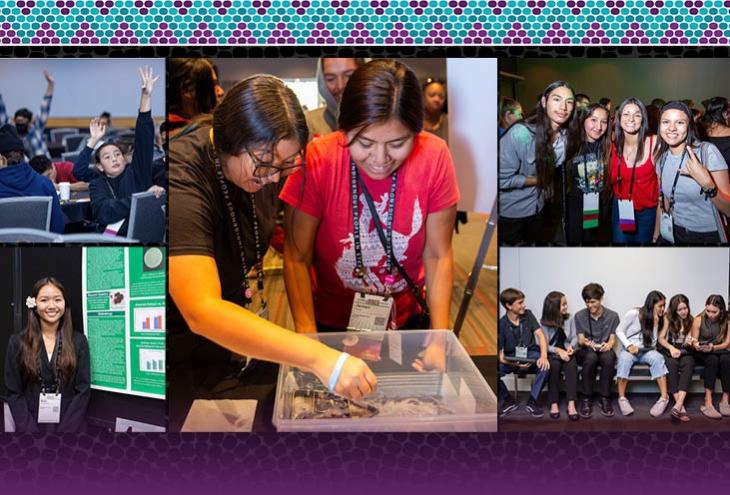The countdown to the AISES National Conference is on! This year’s conference, with the theme Rivers of Resilience — Sustaining Indigenous Innovation, is in San Antonio, Texas, October 3–5. If you’ve never been to an AISES National Conference, it’s an amazing opportunity for Indigenous students and professionals to learn, grow, and share their knowledge. With so much to do and so many people to see, it can be overwhelming. Here are a few ways to get the most out of your time.
Make Sure You’re Able to Go
According to the American Psychological Association, the benefits of attending a conference as a student are many. Be sure to mark the dates on your calendar and resolve any potential scheduling conflicts. If you will miss class, connect with your professors in advance. They will appreciate knowing you’ll be absent, and most will be supportive of this productive time away.
You’ll also need to register for the conference— registration closes on September 20, so don’t delay. If money is an issue, look into grants, scholarships, or funding through your university. Many have a budget for conference registration and/or travel.
Don’t Try to See Everything
There will be dozens of amazing sessions and individuals you’ll want to see throughout the conference. It will be tempting to squeeze in as much as you can, but don’t overdo it. Trying to do too much will lead to less attention and time for the people and presentations that truly interest you. Make a list of your conference priorities, then create a plan. Setting realistic expectations will help you spend meaningful time on what you do participate in.
Be Prepared
Whether you’re giving a presentation or hoping to connect with individuals in your field, some preparation will help you bring your A-game on October 3. Presentations can be nerve-wracking. Practice what you’re going to say and anticipate likely questions. You don’t need to memorize your entire presentation, but you should be comfortable with the material.
If you’re hoping to connect with individuals in your field, prepare what’s often referred to as an elevator pitch — a quick overview of who you are and what you’re interested in learning or connecting about. Being able to share this information quickly and articulately will help you maximize your time and create as many connections as possible.
Network
Networking often starts with an elevator pitch, then goes beyond to interacting with people throughout the conference. Those conversations with people you’re interested in can open opportunities to connect with them after this one event.
According to the Harvard Business Review, for more effective networking you’ll want to avoid small talk and focus on creating genuine connections. Think of questions that are relevant to the person or field you’re both interested in. These conversation starters can help create a deeper connection that will last beyond the conference. Make sure you have ways of reaching others via social media and digital spaces, such as email, LinkedIn, Instagram, and X, and that they have a way to reach you (you may want to create a digital “business card.”)
Keep the Connection Going
Don’t let October 5 be the end of the conference. The connections you make during the National Conference can continue all year and beyond. Send periodic follow-up communications — a quick email, phone call, or text — to the people you met in San Antonio. You may also want to reach out to conference organizers to become involved with next year’s event.
Whether it’s your first time or you’re a seasoned attendee, opportunities abound at the AISES National Conference. We look forward to seeing you in San Antonio!
The AISES National Conference is the largest gathering of Indigenous people who are focused on STEM. It’s a celebration of culture, Native contributions to science, and all that the future holds. It’s hard to leave without feeling renewed and empowered. While you’re moving around the conference, keep these tips in mind:
Actively participate. Take notes during sessions and be sure to record the names and contact information of the people you meet — other students, professors, potential employers — as well as internship or job opportunities. Approach presenters after sessions and ask follow-up questions to learn more about the topic or their journey to their current position. These conversations could help decipher the next steps along your educational and career paths.
Attend your chapter meeting. Meeting with your AISES College Chapter during the conference is a great way to network and learn more about what AISES has to offer.
Visit several booths at the College and Career Fair. After focusing on your main interests, be sure to check out other booths. You can learn so much about companies, potential opportunities, and how STEM applies in a particular field by stopping by booths — even if you don’t think they apply to your interests. The fair makes for a busy day that can result in information overload but push through. Be sure to bring a tote bag or backpack for all the brochures and swag you’ll collect along the way.
Take part in hands-on activities. Pre-college students who have the chance to participate in a STEM activity should do it. Besides being a lot of fun, they’ll gain experience collaborating with professionals, connect with future internship sites, and meet like-minded students.
Browse the Native Artisan Market. Save some spending money because you’ll likely find some treasures handcrafted by talented Native artisans. From colorful ribbon skirts and beadwork to beautiful jewelry and art, there’s so much to see and admire. Have fun!














